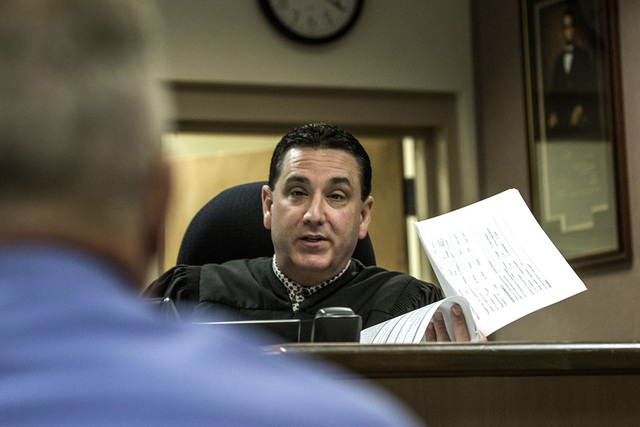Nevada: ‘Hogtying’ at youth facility necessary
Nevada officials on Wednesday said institutional abuse allegations at the Nevada Youth Training Center in Elko were first reported in December, but investigations found that each use of “mechanical restraints” had been necessary.
A restraint technique called “hobbling” is acceptable in cases of youth at high risk of escape or harming themselves or others, officials with the Nevada Department of Health and Human Services said.
However, the Division of Child and Family Services, which oversees the state’s juvenile correctional facilities, doesn’t allow physical or mechanical restraints to be used as punishment.
The hobbling incidents reported by Clark County juvenile inmates earlier this month fall into the category of mechanical restraints, which can involve handcuffs, leg cuffs, waistbands, leather straps, and restraining chairs.
“I have a high level of confidence staff at (Nevada Youth Training Center) continually work to create an environment focused on improving the conditions of confinement and quality of life for incarcerated youth,” Romaine Gilliland, director of the Nevada Department of Health and Human Services, said in a statement released Wednesday. “I look forward to continued discussions that may lead to operational improvement.”
In a hearing last week, Clark County Family Court Judge William Voy called for a review of restraint policies at the Elko facility after juvenile inmates reported being hogtied while in isolation. His request came after receiving reports earlier this month that staff had hogtied juveniles at the Northern Nevada facility. That prompted Voy to order the return of 12 Clark County offenders to his jurisdiction.
Voy didn’t return a call seeking comment Wednesday, but a second hearing on the issue is scheduled for Thursday.
The state Division of Child and Family Services was “extremely concerned” when claims of abuse at the Elko facility were first reported in December, according to its Wednesday statement.
To avoid the conflict of investigating itself, the division directed the Washoe County Department of Social Services to review the reports of abuse and determine whether an investigation was required.
The Washoe department investigated each of the allegations of institutional abuse and determined practices and procedures were appropriately followed and that the allegations were unsubstantiated.
An internal investigation was also conducted by the state Division of Child and Family Services to determine whether each use of force was warranted and whether staff actions were consistent with policies and training.
“It was determined that each use of mechanical restraints was necessary for the situation,” officials said.
The restraining practice at the Elko facility adheres to the American Correctional Association standards, officials said. It was unclear Wednesday whether those standards apply to juvenile correctional facilities, adult correctional facilities or both.
Other organizations disagree.
“The hogtie or hobble position should be considered risky practice and avoided,” according to the American Jail Association, which points out that individuals have suffered asphyxia while hogtied.
But that form of intervention hasn’t been used at the Elko facility since December.
Al Lasso, a personal injury attorney in Las Vegas, represents a client he said was subjected to mechanical restraints at the Elko facility. He said his client will not be making any statements at this time.
“However, once all the facts come out, the public will quickly understand that this is one of the most egregious cases of ongoing child abuse and attempted murder of a child by persons in a position of power,” Lasso wrote in an email. “We will be filing our lawsuit shortly in the hope that it will keep other children safe from such abuse.”
About one in four U.S. juvenile facilities reported using mechanical restraints, and one in five reported locking youth in some type of isolation, according to the 2010 Juvenile Residential Facility Census by the Office of Juvenile Justice and Delinquency Prevention. The report analyzed data from 2,111 facilities across the country.
All juvenile correctional facilities in Nevada go through comprehensive reviews, audits, and unannounced inspections by the Legislative Counsel Bureau’s legislative auditor on governmental and private facilities for children.
Those reviews are to ensure facilities are adequately protecting the health, safety and welfare of those housed there.
According to an Elko center staff report from August, “a youth was instructed to lay in the prone position and did so without incident.” Staff then “entered the youth’s room and placed youth in a belly chain, ankle restraint and then continued by placing the handcuffs on the youth in order to connect the leg irons and belly chains for the hobbles restraint.” Staff “moved the youth to the back of the room. We then exited the room.”
In early December, a youth at Clark County’s Red Rock Academy for juvenile offenders indicated that when he was at the Elko facility he was “hobbled” and “the staff had him lay on the floor and staff cuffed his hand to his leg behind his back.” Later that month, a juvenile at Caliente reported that “he was hogtied 14 times in one day.”
Contact Yesenia Amaro at yamaro@reviewjournal.com or 702-383-0440. Find her on Twitter: @YeseniaAmaro.

















